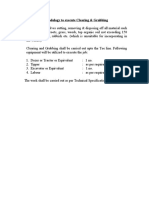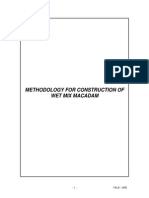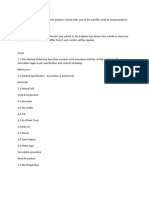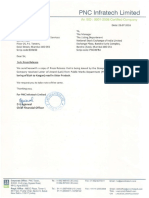Methodology of Hard Shoulder: - 1 - VKLR - Qme
Methodology of Hard Shoulder: - 1 - VKLR - Qme
Uploaded by
Balaji ManneCopyright:
Available Formats
Methodology of Hard Shoulder: - 1 - VKLR - Qme
Methodology of Hard Shoulder: - 1 - VKLR - Qme
Uploaded by
Balaji ManneOriginal Title
Copyright
Available Formats
Share this document
Did you find this document useful?
Is this content inappropriate?
Copyright:
Available Formats
Methodology of Hard Shoulder: - 1 - VKLR - Qme
Methodology of Hard Shoulder: - 1 - VKLR - Qme
Uploaded by
Balaji ManneCopyright:
Available Formats
METHODOLOGY OF HARD SHOULDER
-1- VKLR - QME
Methodology of Hard Shoulder.
1.1 General
This method describes the laying of Hard Shoulder over prepared Granular Sub Base as
per drawing and Tech. Specification No. 407 from Km.164.500 to Km 200.000.
1.2 Temporary Works
Road diversion, drainage diversion etc. shall be done as per site requirement.
1.3 Surveys
i. The surface levels of GSB / Hard Shoulder will be recorded in accordance with
clause 902.3 and tolerances will be kept within limit as specified in Table 900-1,
MOST.
ii. Reference pegs will be fixed on either sides at 600 mm distance from edge lines
at 10 mts longitudinal distances.
iii. Surface undulations will be kept within tolerance and will be checked and
rectified regularly.
iv. Survey of the GSB layer will be done and got approved from RE by submission
of release form, prior to the commencement of Hard Shoulder operation.
1.4 Utilities
Utilities like electric poles, telephone lines etc. will be relocated before starting of
embankment works.
1.5 Traffic Arrangements and Control
i. Temporary signboards will be kept all long the working zone to alert the people.
ii. Flagmen will be arranged to ensure free flow of traffic whenever & wherever
required.
1.6 Access
Access to the work site will be through existing road by providing ramps.
-2- VKLR - QME
1.7 Work Sequence Programme
Testing of selected material
Removal of unwanted material on GSB surface where the Hard Shoulder is being done
Laying of selected material
Leveling the material
Material compaction using Roller / Plate vibrator
Checking of Field density
1.8 Work Methodology
a) Natural gravel shall be obtained from the approved quarry, which is already
approved for subgrade work and also satisfies the present gradation and CBR
requirements.
b) The gravel and sand shall be mixed in suitable proportion to get the requisite
mix.
c) The mixing by suitable mechanical means (such as loader / excavator) shall be
done at the quarry itself by volumetric basis after loosening the quarry material.
d) The mixed up material shall be transported from quarry to the site.
e) Previously prepared GSB layer, if required shall be re-inspected and remedial
action (if any) shall be carried out prior to the delivery of Hard Shoulder material.
f) The material shall be spread in full width of shoulder by motor grader after
making the old surface wet.
g) Water shall be added to the spread material after checking NMC to obtain OMC
from a truck mounted water tanker having sprinkler system and suitable for
applying water uniformly at controlled quantities. Due allowance shall be made
for evaporation losses.
h) After addition of water, material shall be processed and mixed with the help of
ripper attachment and blade of the grader until the layer is uniformly wet.
-3- VKLR - QME
i) Rolling shall be started immediately with the help of vibratory roller. Material shall
be compacted to required density.
j) High spot or depression will be corrected by removing or adding fresh material.
k) All loose segregated or defective areas shall be made good in part or to the full
depth of the layer as required and re-compacted.
l) The shoulder end, facing the WMM layer shall be trimmed off before laying
WMM.
1.9 Inspection and Testing:
1. Continuous level checking while grading is on to ensure proper grade and slope
with the help of reference pegs.
2. Moisture content shall be kept within tolerable limit.
3. Rolling shall be started after OMC limits is checked.
4. All other testing will be done as per section 900 of Tech. Specification.
Quality Control
Eement Visual Inspection Survey
Testing
Sub - Base
Site Material
Finished Work
1.10 Safety:
1. Safety hazards will be identified both at site as well as at quarry site.
2. All the workers and staff will be briefed about the dangerous hazards.
3. Trained operators will be deployed near quarry as well as at site.
4. The height of material in open truck will be always kept less than the height of the
sides of the truck to avoid spilling of material during transport.
5. Sign boards will be kept all along the working zones to alert the people. While
working adjacent to canals / waterways, proper barricading will be done to
ensure safety.
1.11 Environmental:
1. Tippers with back door will be used for transportation.
2. No material will be allowed to fall during transition.
3. Stagnant water (if any) at site will be de-watered prior to start of work at site.
4. Dumping of Hard Shoulder material will be done under controlled conditions.
5. No material will be allowed to go into the existing waterways / canals.
1.12 Reinstatement / Interphasing with Next Stage of Work(s):
1. Construction traffic shall not be allowed on finished surface except in case of
emergency.
2. Any loose pockets or defective spots will be rectified before laying next layer.
-4- VKLR - QME
You might also like
- Guide For Wayfinding SignageDocument5 pagesGuide For Wayfinding SignageVincentYuNo ratings yet
- Metod StatementDocument10 pagesMetod StatementMamy R.75% (4)
- Method Statement For Pile Cap ConcretingDocument8 pagesMethod Statement For Pile Cap ConcretingArifur Rahman Apu100% (8)
- Method Statement For Laying GeomembraneDocument6 pagesMethod Statement For Laying GeomembraneMhando Ignas100% (1)
- Cargo Handling and Stowage: A Guide for Loading, Handling, Stowage, Securing, and Transportation of Different Types of Cargoes, Except Liquid Cargoes and GasFrom EverandCargo Handling and Stowage: A Guide for Loading, Handling, Stowage, Securing, and Transportation of Different Types of Cargoes, Except Liquid Cargoes and GasRating: 5 out of 5 stars5/5 (11)
- Structural Design For BillboardDocument4 pagesStructural Design For BillboardKaleb George0% (1)
- All Pavement MethologiesDocument17 pagesAll Pavement MethologiesCharismatic Srini VasanNo ratings yet
- Embankment Construction MethodologyDocument16 pagesEmbankment Construction MethodologyTinwin HtutNo ratings yet
- BS - 120 FinalDocument15 pagesBS - 120 FinalRitesh KumarNo ratings yet
- 20 - WIAL Runway Extension - Draft AECOM Concept Feasibility and Design ReportDocument61 pages20 - WIAL Runway Extension - Draft AECOM Concept Feasibility and Design ReportBobby SetiawanNo ratings yet
- IRC - 67 - Traffic Signs PDFDocument61 pagesIRC - 67 - Traffic Signs PDFmani0214No ratings yet
- Method Statement Road Work - MORTHDocument18 pagesMethod Statement Road Work - MORTHCivil FundaNo ratings yet
- WMMDocument4 pagesWMMAnonymous YHcvra8Xw6No ratings yet
- BCDocument5 pagesBCjitendraNo ratings yet
- Methodology For Laying of Kerb Concrete: - 1 - VKLR - QmeDocument5 pagesMethodology For Laying of Kerb Concrete: - 1 - VKLR - QmevaideehNo ratings yet
- Piling Rigs Overturning On Construction Sites: A Guide To Loss PreventionDocument4 pagesPiling Rigs Overturning On Construction Sites: A Guide To Loss Preventionmohd addinNo ratings yet
- Ms-Excavation and BackfillingDocument14 pagesMs-Excavation and Backfillingahmed atifNo ratings yet
- NP4 Pipe Installation and Backfill - MethodologyDocument4 pagesNP4 Pipe Installation and Backfill - MethodologyRabnawaz Imam100% (1)
- Method Statement For BACK FILLING FinalDocument4 pagesMethod Statement For BACK FILLING FinalEngr Muhammad SohailNo ratings yet
- Method StatementDocument5 pagesMethod StatementTariq KhanNo ratings yet
- 07 MS-GSBDocument5 pages07 MS-GSBSK Emran AliNo ratings yet
- MOS - Flexible Pavement RehabilitationDocument6 pagesMOS - Flexible Pavement RehabilitationcdipcinNo ratings yet
- ABC OverlayDocument5 pagesABC OverlayChemicro HoldingsNo ratings yet
- Method Statement - BOX CULVERTDocument5 pagesMethod Statement - BOX CULVERTjps.anienurinaNo ratings yet
- Road Construction Method Statement-Embankment ConstructionDocument6 pagesRoad Construction Method Statement-Embankment ConstructionGayantha ThanushkaNo ratings yet
- Method of Statement Road WorkDocument10 pagesMethod of Statement Road WorkAbu NijamNo ratings yet
- Method Statement - PIPE JACKINGDocument4 pagesMethod Statement - PIPE JACKINGgavin siaNo ratings yet
- Method Statement-Manshield MethodDocument7 pagesMethod Statement-Manshield Methodasr.engineering2023No ratings yet
- Embankment MethodologyDocument4 pagesEmbankment MethodologyAVP PAFCDO ProjectNo ratings yet
- Backfilling Method StatDocument7 pagesBackfilling Method StatnmohamedriyasNo ratings yet
- MS For Replacing Soft Soil With Permeable MaterialsDocument7 pagesMS For Replacing Soft Soil With Permeable MaterialsThushara WickramasuriyaNo ratings yet
- Ravi Sir DLC PresentationDocument13 pagesRavi Sir DLC Presentationসৌগত রায় ঘটকNo ratings yet
- MoS For Earth WorksDocument17 pagesMoS For Earth WorksMohammed Amer PashaNo ratings yet
- UPE MOS Jacking & ShaftDocument10 pagesUPE MOS Jacking & ShaftbtleoNo ratings yet
- 255 Detailed Work MethodologyDocument3 pages255 Detailed Work MethodologyBOBANSO KIOKONo ratings yet
- Methodology For Soil ShoulderDocument7 pagesMethodology For Soil ShoulderAkash SarkarNo ratings yet
- Foundations: Continuous Flight Auger PilingDocument9 pagesFoundations: Continuous Flight Auger PilingSyed ZamanNo ratings yet
- NO.19MS For Replacing Soft Soil With Permeable Materials at DK 22+640 DK 22+810Document7 pagesNO.19MS For Replacing Soft Soil With Permeable Materials at DK 22+640 DK 22+810Amila Priyadarshana DissanayakeNo ratings yet
- BQA-01 Method Statement For Site Grading & Excavation - REV-1 ApprovedDocument5 pagesBQA-01 Method Statement For Site Grading & Excavation - REV-1 ApprovedVeronica De Jesus100% (1)
- Method Statement of Rectification Roadwork D1-1B2 Table of ContentDocument5 pagesMethod Statement of Rectification Roadwork D1-1B2 Table of ContentFa DylaNo ratings yet
- Method Statement For Earthwork Excavation & BackfillingDocument6 pagesMethod Statement For Earthwork Excavation & Backfillingjing aytona100% (1)
- Method Statement For EarthworksDocument3 pagesMethod Statement For EarthworksNorendro Kangjam100% (1)
- Abc & PrimingDocument4 pagesAbc & Primingsatheek0% (1)
- Method Statement For ExcavationDocument7 pagesMethod Statement For ExcavationAbideen Raheem100% (1)
- MEthdstatemet For GRP Pipe Puddle Flange Installation (Complete)Document13 pagesMEthdstatemet For GRP Pipe Puddle Flange Installation (Complete)Mdubdt100% (1)
- D345-MS For Backfilling - 09.01.2023Document2 pagesD345-MS For Backfilling - 09.01.2023naseerdropboxNo ratings yet
- T-242 - Method Statement For Excavation & BackfillDocument9 pagesT-242 - Method Statement For Excavation & Backfillsindalisindi100% (1)
- Method Statement - BackfillDocument8 pagesMethod Statement - BackfillJurie_sk3608100% (2)
- Sub BaseDocument5 pagesSub BaseChemicro HoldingsNo ratings yet
- Method Statement For Excavation Compaction and BackfillingDocument8 pagesMethod Statement For Excavation Compaction and BackfillingIna RoseNo ratings yet
- Method Statement Excavation Works ScribdDocument8 pagesMethod Statement Excavation Works ScribdMoshotle InnocentNo ratings yet
- MOS EarthworksDocument5 pagesMOS EarthworksMohd Hafizan100% (1)
- 001 Site ClearingDocument7 pages001 Site ClearingFara Atika Bha NeyNo ratings yet
- Rock fill embankment methodologyDocument3 pagesRock fill embankment methodologyRaoNo ratings yet
- Method Statement For Granular Sub BaseDocument5 pagesMethod Statement For Granular Sub Basemadhu arepelli100% (3)
- Method Statement For Compaction and BackfillingDocument8 pagesMethod Statement For Compaction and BackfillingJohn MofireNo ratings yet
- Bitumenous SurfacingDocument6 pagesBitumenous SurfacingChemicro Holdings100% (1)
- Method StatementDocument11 pagesMethod StatementABDELHAMID AbdelhamidNo ratings yet
- Mos RoadworksDocument12 pagesMos RoadworksfareesyaNo ratings yet
- Lifting ProcedureDocument4 pagesLifting Procedurefirdaus yusufNo ratings yet
- Risk Assessment What Work Excavation Work With Help of JCB Location PM Warehouse Area Contractor Company-Aalanna Project PVT LTDDocument2 pagesRisk Assessment What Work Excavation Work With Help of JCB Location PM Warehouse Area Contractor Company-Aalanna Project PVT LTDhemant yadav33% (3)
- Method of StatementDocument17 pagesMethod of StatementhanyalramadyNo ratings yet
- General Condtionsfor TFTRDocument20 pagesGeneral Condtionsfor TFTRRaju AketiNo ratings yet
- International Regulations for Preventing Collisions at SeaFrom EverandInternational Regulations for Preventing Collisions at SeaNo ratings yet
- Method Statement For Casting of Precast Facia Panel: - 1 - VKLR, QmeDocument3 pagesMethod Statement For Casting of Precast Facia Panel: - 1 - VKLR, QmeBalaji ManneNo ratings yet
- Construction Methodlogy For Well Foundation: - 1 - VKLR, QmeDocument4 pagesConstruction Methodlogy For Well Foundation: - 1 - VKLR, QmeBalaji ManneNo ratings yet
- Weather and Climate Extremes: Donald A. Wilhite, Mannava V.K. Sivakumar, Roger PulwartyDocument10 pagesWeather and Climate Extremes: Donald A. Wilhite, Mannava V.K. Sivakumar, Roger PulwartyBalaji ManneNo ratings yet
- Drought Analysis Using Geo-Spatial Techniques For Hisar District, HaryanaDocument4 pagesDrought Analysis Using Geo-Spatial Techniques For Hisar District, HaryanaBalaji ManneNo ratings yet
- 12 Zhou PDFDocument6 pages12 Zhou PDFBalaji ManneNo ratings yet
- Letter No 1080 Submission of Method Statement For Construction of PSC Box Girder For Span PL10 - PL 13 of Jagatpur Flyover.Document33 pagesLetter No 1080 Submission of Method Statement For Construction of PSC Box Girder For Span PL10 - PL 13 of Jagatpur Flyover.Balaji ManneNo ratings yet
- Fat Trap TF-4Document1 pageFat Trap TF-4Aldeline SungahidNo ratings yet
- Shaping Portland: Anatomy of A Healthy City (Routledge Research in Planning and Urban Design) - ISBN 1138693448, 978-1138693449Document23 pagesShaping Portland: Anatomy of A Healthy City (Routledge Research in Planning and Urban Design) - ISBN 1138693448, 978-1138693449maepettifordxjj100% (11)
- European-Semester Thematic-Factsheet Transport enDocument25 pagesEuropean-Semester Thematic-Factsheet Transport enIon DouNo ratings yet
- VIOS Minor Change 2015Document1 pageVIOS Minor Change 2015Idris AhmadNo ratings yet
- Rural Roads PDFDocument128 pagesRural Roads PDFFernando Padua ArceNo ratings yet
- Coach & Wagon BogiesDocument156 pagesCoach & Wagon BogiesAmanpreet Singh100% (1)
- Professional PilgrimDocument16 pagesProfessional PilgrimAshutosh MohanNo ratings yet
- Ilevia Spring 2024Document25 pagesIlevia Spring 2024Jonas LubNo ratings yet
- 180 - Use of English Vocabulary Test DDocument6 pages180 - Use of English Vocabulary Test DІрина ВичужанінаNo ratings yet
- Start Up & Shut Down Procedures Underground LoadersDocument1 pageStart Up & Shut Down Procedures Underground LoadersGustavoNo ratings yet
- v0650028000 Full Accessories Catalogue 2017 2018 PDFDocument84 pagesv0650028000 Full Accessories Catalogue 2017 2018 PDFDragos BmrNo ratings yet
- Street Lighting Section 12 Drawings: Design Standards For Urban InfrastructureDocument30 pagesStreet Lighting Section 12 Drawings: Design Standards For Urban InfrastructureSyeda Turan NaqviNo ratings yet
- Unit 6 Short Test 2B: GrammarDocument1 pageUnit 6 Short Test 2B: GrammarMinh TruongNo ratings yet
- C200-Roadworks Notes and Details-C240Document1 pageC200-Roadworks Notes and Details-C240Don WangNo ratings yet
- Attock 1 17 PDFDocument164 pagesAttock 1 17 PDFjunaid112No ratings yet
- RS-H Brochure 0Document2 pagesRS-H Brochure 0fitratulqadriNo ratings yet
- PNC Infratech Limited Bags Rs.233 Crore PWD Road Project in UP (Company Update)Document2 pagesPNC Infratech Limited Bags Rs.233 Crore PWD Road Project in UP (Company Update)Shyam SunderNo ratings yet
- Flying CarDocument29 pagesFlying CarKunal Mehra0% (1)
- NCHRP Syn 122Document146 pagesNCHRP Syn 122Ahyun Wursita LuhungNo ratings yet
- Chapter 1-3Document25 pagesChapter 1-3Janley AresNo ratings yet
- TABCDocument2 pagesTABCSteveeeeeenNo ratings yet
- Problem in Delhi and SolutionsDocument4 pagesProblem in Delhi and SolutionsswarnimNo ratings yet
- Work Zone SafetyDocument45 pagesWork Zone SafetyShahid Bhatti100% (1)
- Recent Major Bridges in KoreaDocument12 pagesRecent Major Bridges in KoreaMario Alejandro Suarez RodriguezNo ratings yet
- Eps SDocument1 pageEps Sbryan floresNo ratings yet
- Raytech Retail Price ListDocument1 pageRaytech Retail Price ListAndy AG100% (1)































































































